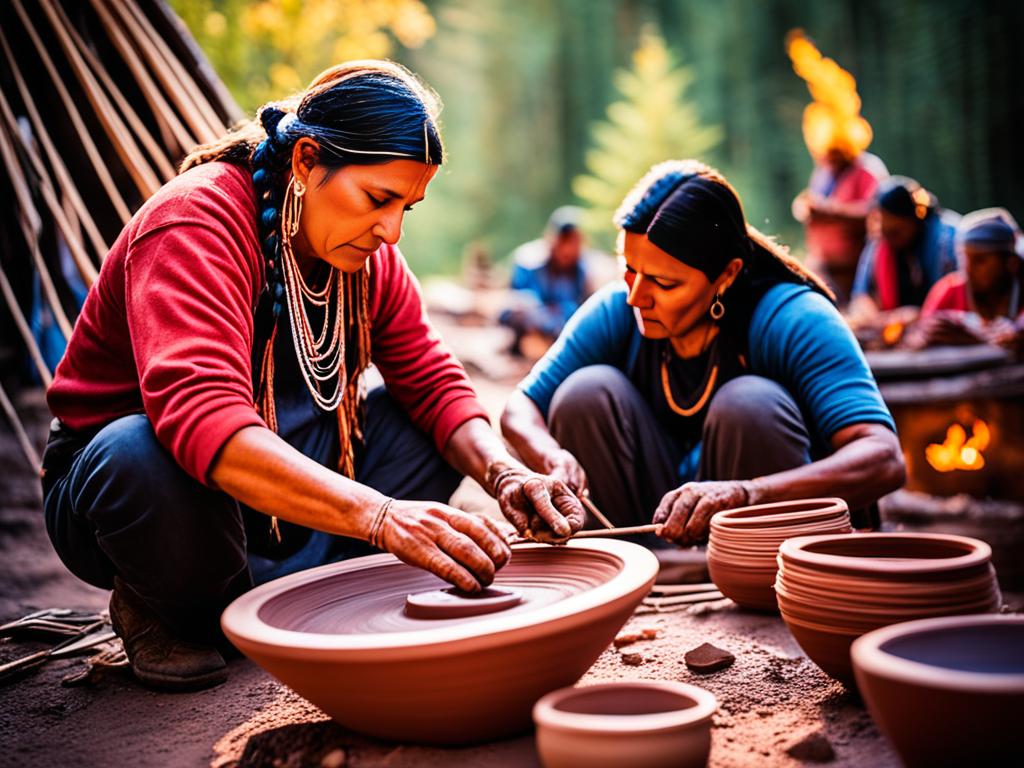Welcome to a world where ancestral wisdom meets artistic craftsmanship, breathing life into age-old traditions. The Renaissance of Indigenous Arts and Crafts is a powerful movement that celebrates the cultural heritage and creative spirit of Indigenous communities. Through their masterful creations, artisans honor their ancestral wisdom and nurture a sense of community that transcends boundaries.
Indigenous arts and crafts have long served as a vital link to the past, preserving the stories, rituals, and knowledge of past generations. From intricate beadwork to mesmerizing woodcarvings, each piece is a testament to the deep connection Indigenous communities have with their roots. These art forms not only honor their ancestors but also provide a tangible expression of cultural identity and pride.
Key Takeaways:
- The Renaissance of Indigenous Arts and Crafts breathes new life into age-old traditions.
- Indigenous arts and crafts preserve ancestral wisdom and pass down cultural traditions.
- These art forms foster a sense of community and cultural identity.
- The creativity and skill of Indigenous artisans have a global influence on the art scene.
- Supporting Indigenous artists and their contributions ensures the continuity of Indigenous arts for future generations.
Exploring Ancestral Wisdom: A Window to the Past
Indigenous arts and crafts offer a profound connection to ancestral wisdom, serving as a window to the past. These artistic expressions are imbued with centuries-old knowledge and cultural traditions, providing invaluable insights into the histories and worldviews of Indigenous communities.
The creation of Indigenous arts and crafts is deeply rooted in reverence for nature, spirituality, and the collective wisdom passed down through generations. Each art form carries unique symbols, patterns, and techniques that reflect the cultural identity of the community it originates from.
Through the meticulous craftsmanship of Indigenous artisans, these art forms become vessels for storytelling, providing a means to preserve cultural traditions and transmit ancestral wisdom to future generations. The intricate beadwork, exquisite pottery, and intricate basket weaving are not merely artistic endeavors; they are repositories of cultural knowledge and a testament to the resilience and creativity of Indigenous peoples.
Indigenous arts and crafts also play a vital role in the oral traditions of Indigenous communities. They serve as visual representations of oral histories, myths, and legends, bridging the gap between the tangible and intangible aspects of cultural heritage. Each piece of artwork tells a story, conveying messages of identity, spirituality, and resilience.
“Indigenous art allows us to connect with our ancestors and preserve our cultural heritage. It is a way for us to express our identity, share our stories, and keep our traditions alive for future generations.”
By exploring Indigenous arts and crafts, we not only gain a deeper appreciation for their aesthetic beauty but also tap into a wellspring of ancestral wisdom. These art forms offer insights into Indigenous cosmologies, philosophical perspectives, and sustainable relationships with the natural world.
As we engage with Indigenous arts and crafts, we are reminded of the profound interconnectedness between human beings, nature, and the spiritual realm. We learn from the past, drawing lessons and inspiration that can guide us towards a more harmonious and sustainable future.
| Art Form | Origin | Meaning |
|---|---|---|
| Beadwork | Various Indigenous cultures across North America | Symbolizes spiritual connection, stories, and cultural identity |
| Pottery | Pueblo tribes of the Southwest | Represents traditions, fertility, and sacred connection to the Earth |
| Basket Weaving | Indigenous cultures worldwide | Symbolic of community, unity, and sustainable practices |
Through exploring Indigenous arts and crafts, we honor and celebrate the rich legacy of ancestral wisdom, fostering a deeper understanding and appreciation of Indigenous cultures. These artistic expressions serve as a reminder of the resilience, creativity, and cultural vibrancy of Indigenous communities throughout history.
Contemporary Indigenous Artists: Global Influence and Innovation
Contemporary Indigenous artists have emerged as influential figures in the global art scene, captivating audiences with their unique perspectives and innovative techniques. These artists draw inspiration from their rich cultural heritage, bridging traditional art forms with modern aesthetics to create captivating and thought-provoking works.
Their art serves as a powerful medium of expression, capturing the complexities of Indigenous experiences, histories, and struggles. Through their creations, contemporary Indigenous artists challenge stereotypical narratives and showcase the diverse perspectives of Indigenous communities worldwide. Their work invites viewers to engage with Indigenous cultures in a meaningful and authentic way, fostering understanding and appreciation.
From vibrant paintings and sculptures to multimedia installations and performance art, contemporary Indigenous artists continuously push boundaries and redefine artistic norms. Their creations often incorporate traditional Indigenous symbols and storytelling techniques, infusing them with contemporary elements that reflect the realities of a rapidly changing world.
“Through my art, I aim to honor the wisdom of my ancestors while exploring new possibilities for artistic expression,” says Eliza Samuels, a renowned contemporary Indigenous artist from the Navajo Nation. “I believe art has the power to transcend cultural barriers and create connections that foster empathy and respect.”
By showcasing their art on global platforms, these artists not only gain recognition and appreciation but also influence the broader art community. Their innovative approaches and unique perspectives challenge conventional notions of art, inspiring artists from diverse backgrounds to explore new artistic horizons.
Furthermore, contemporary Indigenous artists are at the forefront of conversations around representation and decolonization in the art world. They actively advocate for the recognition and celebration of Indigenous artistic practices, challenging the exclusionary practices of traditional art institutions. By asserting their voices and reclaiming their narratives, these artists contribute to a more inclusive and equitable art world.
Influence and Recognition: A Glimpse at Noteworthy Contemporary Indigenous Artists
Let’s take a closer look at some of the contemporary Indigenous artists who have made a significant impact on the global art scene:
| Artist | Origin | Artistic Medium |
|---|---|---|
| Jaune Quick-to-See Smith | Salish and Kootenai | Painting, Printmaking, Mixed Media |
| Dana Claxton | Hunkpapa Lakota | Photography, Film, Installation |
| Brian Jungen | Dunne-za | Sculpture, Installation |
| Emily Kame Kngwarreye | Anmatyerre | Painting |
These artists, among many others, have received international recognition for their extraordinary contributions to the contemporary art world. Their works have been exhibited in prestigious galleries and museums worldwide, bringing Indigenous perspectives to a global audience and challenging established artistic norms.
As contemporary Indigenous artists continue to break barriers, their influence and innovation resonate beyond the art world, enriching cultural discourse and promoting a greater understanding of Indigenous cultures. Through their captivating works, they inspire dialogue, celebration, and appreciation of the rich artistic traditions that have shaped Indigenous communities for centuries.
Indigenous Arts and Community Building
Indigenous arts play a pivotal role in community building, nurturing a sense of cultural pride, identity, and connection among Indigenous peoples. These arts encompass a wide range of creative expressions, including visual arts, music, dance, storytelling, and traditional crafts.
Through the practice and preservation of Indigenous arts, communities come together to celebrate and honor their cultural heritage. Artistic traditions are passed down from one generation to the next, ensuring the continuity of ancestral knowledge and wisdom.
These arts not only represent the vibrant tapestry of Indigenous cultures but also serve as a powerful tool for addressing social, economic, and educational challenges faced by Indigenous communities.
At the social level, Indigenous arts create spaces for gatherings, celebrations, and healing. They provide platforms for storytelling, where community members share their experiences, history, and collective memory. By sharing narratives and cultural practices through art, Indigenous communities are able to strengthen their bonds and foster a sense of belonging.
The economic impact of Indigenous arts cannot be overlooked. These artistic traditions often serve as a source of livelihood for many Indigenous artists and artisans. Through the creation and sale of their artworks and crafts, they contribute to the economic development of their communities. Moreover, Indigenous arts also attract tourists and visitors, promoting cultural exchange and sustainable tourism.
Additionally, Indigenous arts have a significant role to play in education. They serve as a valuable resource for teaching and learning, providing insights into historical events, environmental stewardship, and traditional knowledge. Indigenous art forms have the power to engage students, promoting cross-cultural understanding and bridging the gap between Indigenous and non-Indigenous communities.
To fully appreciate the impact of Indigenous arts on community building, it is important to recognize and support the talented artists and artisans within these communities. By valuing and investing in Indigenous arts, we not only preserve cultural heritage but also create opportunities for economic growth, social cohesion, and educational enrichment.
As we celebrate and promote Indigenous arts, we contribute to a more inclusive and diverse society, where the cultural contributions of Indigenous peoples are acknowledged, respected, and cherished.
Indigenous Arts and Community Benefits
| Benefit | Description |
|---|---|
| Social Cohesion | Indigenous arts bring communities together, fostering a sense of belonging and shared identity. |
| Economic Development | Indigenous arts provide livelihood opportunities and contribute to the growth of local economies. |
| Educational Enrichment | Indigenous arts serve as a valuable resource for teaching and learning, promoting cultural understanding and cross-cultural education. |
Challenges and Triumphs: Nurturing Indigenous Arts
Preserving and promoting Indigenous arts and crafts comes with its fair share of challenges. From the pressures of globalization to the limited access to resources and funding, Indigenous artists face numerous obstacles in their pursuit of keeping their ancestral traditions alive. However, it is through these challenges that their tenacity and resilience shine, showcasing the triumphs that come with nurturing Indigenous arts.
One of the biggest challenges faced by Indigenous artists is the commercialization and appropriation of their cultural expressions. As Indigenous arts gain recognition worldwide, there is often a risk of misinterpretation and exploitation. Indigenous artists must navigate this delicate balance of sharing their culture while protecting its sacredness and authenticity.
“The challenge lies in ensuring that our cultural heritage is respected and preserved, while also embracing the opportunities to share our art with the world,” explains Aiyanna, a Navajo weaver and artist.
Moreover, limited access to resources, such as art supplies, training, and mentorship programs, can pose significant challenges to Indigenous artists seeking to develop and refine their skills. Many artists must rely on their own ingenuity and resourcefulness to overcome these barriers, finding innovative solutions to create meaningful and culturally significant artworks.
However, despite these challenges, Indigenous artists continue to find triumphs in their journey. Through their art, they reclaim their cultural identity, challenge stereotypes, and create spaces for dialogue and empowerment within their communities. Indigenous arts become a powerful medium for storytelling, preserving histories, and advocating for social justice and environmental sustainability.
The triumphs of Indigenous artists extend beyond the confines of their communities. Their works have gained recognition and respect on a global scale, elevating the discourse around Indigenous arts and challenging dominant narratives. In doing so, they inspire and empower future generations to embrace their cultural heritage and contribute to the ongoing renaissance of Indigenous arts.
Nurturing Indigenous Arts: Building a Supportive Ecosystem
To ensure the continuity and growth of Indigenous arts, it is crucial to establish a supportive ecosystem that addresses the challenges faced by Indigenous artists. This includes providing equitable access to resources, encouraging collaborations, and fostering dialogue between Indigenous artists and the wider artistic community.
Funding programs that specifically cater to Indigenous artists can play a pivotal role in nurturing Indigenous arts. By allocating resources to support training, art production, and cultural events, these initiatives can empower Indigenous artists to navigate the challenges they face and thrive in their artistic practices.
Cultural institutions, galleries, and curators also have an important role to play in bridging the gap between Indigenous artists and the mainstream art world. By actively seeking out and showcasing Indigenous artworks, these institutions can promote understanding, appreciation, and the diverse perspectives that Indigenous arts offer.
Nurturing Indigenous arts is not only a responsibility shared by Indigenous communities but also a collective effort that involves governments, organizations, and individuals. By fostering an inclusive and supportive environment for Indigenous artists, we can ensure the continuation of their rich traditions, celebrate their triumphs, and appreciate the immense contributions they make to our cultural heritage.
| Challenges | Triumphs |
|---|---|
| Commercialization and appropriation of cultural expressions | Reclaiming cultural identity and challenging stereotypes |
| Limited access to resources and funding | Nurturing creativity and innovation |
Conclusion
Throughout this article, we have explored the Renaissance of Indigenous Arts and Crafts. We have witnessed how these ancient traditions have resurged to become vibrant, meaningful expressions of ancestral wisdom and community.
Indigenous arts and crafts provide a powerful window to the past, preserving and sharing cultural knowledge that spans generations. These art forms breathe life into stories, traditions, and values, bridging the gap between the past and the present.
We have also seen the impact of contemporary Indigenous artists, who have pushed boundaries and gained global recognition for their innovative work. Their ability to blend traditional techniques with modern approaches has created a new frontier for Indigenous art, inspiring new generations of artists.
Supporting the Renaissance of Indigenous Arts and Crafts is not only about celebrating cultural heritage; it is a vital act of empowerment for Indigenous communities. By valuing and investing in these artistic expressions, we contribute to the social, economic, and educational development of these communities.
In conclusion, the Renaissance of Indigenous Arts and Crafts is a testament to the resilience, creativity, and cultural richness of Indigenous peoples worldwide. Let us continue to honor and support Indigenous artists, recognizing their invaluable contributions to global artistic expression and the preservation of cultural diversity.







